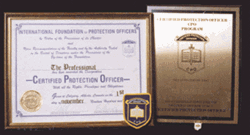|
Training can be the difference between being a Security Officer and being a Security Professional!

Security is a rapidly evolving industry. As the needs of business and industry grow, so do the responsibilities
of the private security officer. With this increase in responsibility there is a growing demand for responsible,
well-trained personnel to fulfill security and safety needs.
The security officer of today is responsible for:
- Relations with employees, clients and the public.
- Physical security
- Safety
- Fire Protection
- Access control of both persons and packages
- Employee theft prevention
- Investigation
- Developing and initiating emergency plans
- Traffic control
- Crowd Management
These responsibilities are very important and they must be performed with the minimum degree of error.
We do not need the Security Officer of the past, we need the Security Professional of today.
Training is one of the keys to this challenge. No longer can we hire someone and put them on assignment with only a new uniform and a quick verbal job description. Many states require an initial amount of training for a person to become authorized to work in the security field in that state. A background check is performed and the training is recorded. Much of this training is designed to be based to teach to a minimum level. Our training is designed for those that want to take their profession to the next level.
What are the benefits of training?
-
Increased job efficiency where specific job taks are performed better
-
Better relations between employees and management
-
Enhansed professional idenity by security officers who see positive growth within themselves
-
Pride and job satisfaction
-
increased loyalty to the employer who has shown an intrest in the employees by training them
-
Decreased turnover as there are fewer situations that make officers feel uncomfortable and incompetent
-
Fewer mistakes
-
Decreased accidents
-
Improved discretionary judgement with better decisions being made
-
Protection from allegations that management is negligent in preparing officers to perform their jobs
Courses Offered
Basic Security Overview Training
This is an course that will cover the following;
-
Role of the Security Officer
-
Typical Assignments
-
Patrol Techniques
-
Access Control
-
Observation
-
Reporting
-
Pro-active Prevention vs. Reactive
-
Security Liaison with Public Law Enforcement.
This is a great course for entry level personel and is based off of the Security Guard Course for NY and CT.
Length - 8 Hours
Cost - $50.00
Terrorism Awerenss for The Security Professional
Security officers are often the first line of defense in protecting the assets and preventing losses for their employer or their employer's clients. In this class you will learn about terrorism, terrorists and how they operate, and terrorism groups, both international and domestic that operate within the U.S.
The first step in active participation in Homeland Security prevention is a belief in the threat. This belief can only occur if there is a strong awareness of who the enemy is, how targets are chosen, how easily they can be exploited and what that exploitation represents.
Upon completion of this class, you will be able to: - Know the definition of terrorism. - Identify terrorist operations and define the level of destructiveness. - Identify diffrent types Weapons of Mass Destruction (WMDs) and their impact and threats. - Identify international terrorist groups operating in the U.S. - Identify domestic terrorist groups that operate in the contentental United Sates and the signs of possible terrorist group involvement
Due to the security sensitivity of this course, only personal with Law Enforcement, Military or verifiable Security Identification will be allowed to attend.
Length - 8 hours
Cost - $199.00
Certified Protection Officer Review Course- International Foundation For Protection Officers
The CPO course was created by the International Foundation of Protection Officers in 1988  to provide "current, useful, consolidated Security Training Manual that provides vital ‘need to know’ information for Protection Officers throughout the Security Industry." The CPO training involves the Protection Officer Training Manual, which consists of 30 plus chapters, each dealing with a separate topic that is essential to the efficient functioning of a security officer. Each chapter is followed by summary questions. There is an open book, unsupervised midterm and a proctored final exam. If the final exam is completed within one year of the student’s enrollment within the course and they have obtained a score of 70% or greater then they have earned the title of Certified Protection Officer. This course includes enrollment in the CPO course, an 8 hour course review as well as the proctor for the final exam. Units of study include such topics as: •Public Relations •Investigations •Report Writing •Physical Security •Crime Scenes •Emergency Procedures •Safety Procedures •Workplace Violence •Environmental Crime Control Theory •Defensive Tactics & Officer Safety •Traffic & Crowd Control •Hazardous Materials •Effective Communications •Weapons of Mass Destruction •Apprehension and Detention Procedures •Fire Prevention •Strikes/Labor Relations •Crisis Intervention •Bomb Threats •Professionalism and Ethics •Police Security Liaison •Operational Risk Management •Foundations for Surveillance •Use Of Force •Legal Aspects
Review Course Length - 8 Hours.
Cost - $375.00
|